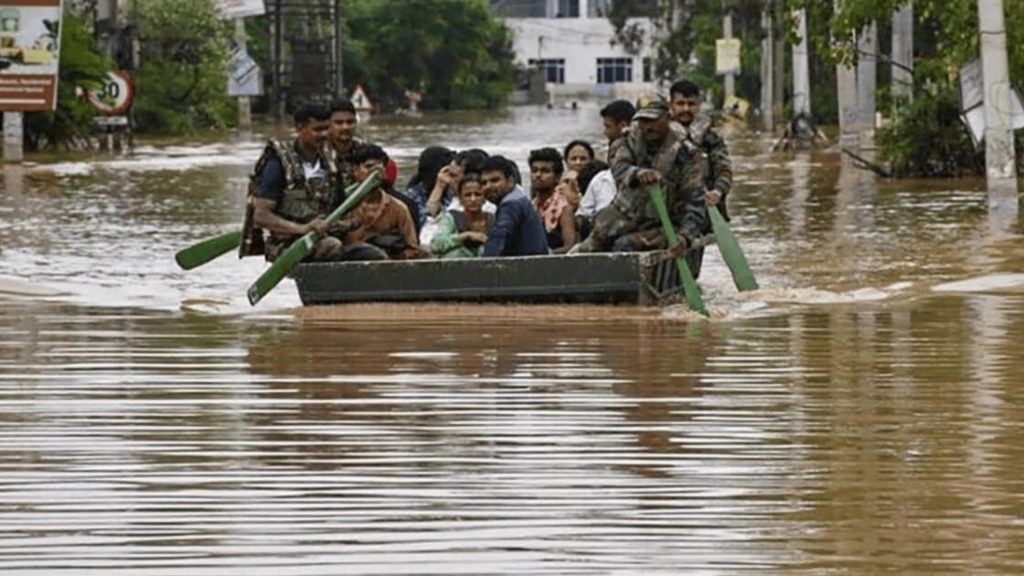
While the continuous torrential rains have already claimed many lives and caused extensive damage to properties and crops in HP and neighbouring Punjab, experts wonder whether the widespread devastation should be blamed on the downpour alone. A report by Rajesh Moudgil
The massive downpour this monsoon so far has left Himachal Pradesh in a state of shock and mourning; flash floods, landslides and cloudburst have already claimed over 360 lives while at least 40 persons are still reported missing. The missing people include the ones who either got washed away in the sudden flooding in rivers and rivulets across the hill state and the ones who got buried under the debris of landslides.
On the other hand, the number of people injured in these catastrophic accidents has already crossed 340. While over 2,300 houses in different districts of the state – including Shimla, Kullu and Manali and Mandi – have been completely lost, the number of houses partially damaged has crossed 10,000. These are besides over 300 shops and over 5,000 cowsheds.
According to state estimates, it has suffered monetary loss of over Rs 8,500 crore in over 156 incidents of landslides and 63 incidents of flash floods in which the hilly state has also lost a plethora of human, cattle lives and official and commercial buildings.
And even though the teams of National Disaster Response Force (NDRF) as well as various state agencies promptly responded to the havoc caused by plural factors, rescue works are still in progress at several rural interiors and urban locations of Shimla, Kullu and Mandi districts, besides other places.
Many factors behind catastrophe: Experts
Bemoaning the losses, Prof Sushil Kumar Sharma, an expert on sustainable development and communication, says the devastation in the Western Himalayas region of Himachal Pradesh and Uttarakhand is a result of many factors like unprecedented rains due to adverse weather conditions, haphazard construction, inactions of regulatory authorities, building of large hydro-power and road projects, and over-aged forest stands.
The colossal destruction in Himachal Pradesh and Uttarakhand was created by rise in temperature and the warming-up land which enhanced humidity ultimately resulting in increasing the intensity of rains. Hence heavy rains that have been received by these hilly states so far. The spells of heavy rainfall were also caused due to Northside movement of the axis of the monsoon trough or low-pressure, causing heavy or very heavy rains all over the Himalayas.

Also, this year the active Western Disturbances travelled across the Himalayas during the monsoon trough periods, which resulted in very heavy rainfall and flash floods, causing more devastation in view of the haphazard construction of houses and ongoing and completed larger power and road projects. The land use planning for urban and rural areas for inhabitation and other purposes have not been done.
There are multiple authorities to provide permission for projects and houses. State authorities give clearance to all state run projects, completing the paper formalities. For example, see Shimla and Solan, not the riverside towns, and Kullu and Mandi, the riverside towns, which received high devastation. The constructions in these towns were not only haphazard, but throwing all norms away due to political interference or other material influences. River waters are over-exploited to get more energy.
Hills are destabilised during the construction of big and small road projects. Debris from these projects may be disposed of anywhere, this ultimately goes to the waters. The unscientific construction activities in larger hydro-power or road projects have added to the severity of destruction.
Also, the over-aged tree-lands, forests, standing for over two to three centuries, need to be replaced with new trees after a century, to allow the flora to provide lively and fullest environment services. Immediate actions are required in a holistic manner to create the sustainability in development systems and to avoid unfortunate heavy and huge loss of life and property.
Situation grim in Punjab
The heavy rains leading to flash floods in Himachal Pradesh has also had adverse impact on its immediate neighbour Punjab vast areas of which also got inundated due to ongoing heavy rains in the region as well as release of water – though in a controlled manner – from the Pong dam on the Beas river and Bhakra dam on Sutlej – due to torrential rains in the catchment areas of neighbouring Himachal Pradesh.
According to information, Punjab has already seen more than 40 deaths, many reported missing, and flooding in literally tens of thousands of acres of farm land – and ruining the standing crops – across the state. According to reports, while more than 18,000 villages were severely affected due to water-logging, the NDRF and state agencies had rescued over 20,000 people or shifted them to safer places.
Punjab too had torrential rains and in addition had spates in Sutlej and Beas rivers which also affected numerous rivulets and drains.
Pertinently, the Bhakra and Pong dams which had huge and excessive water inflow in their respective catchment areas due to torrential rains. The inflow was said to be 1.28 lakh cusecs into Bhakra Dam and 1.58 lakh cusecs into Pong Dam on August 23 last and it was 1.05 lakh cusecs and 58,702, respectively, a little earlier.
The dams had to, thus, release the water downstream Punjab. The water is released so as to check the rising water level almost up to the brim of the reservoirs of the two dams. Both these dams are built on hilly state’s borders with Punjab. The most affected areas have been Ropar, Nawanshahr, Kapurthala, Jalandhar, Hoshiarpur, Sangrur, Moga, Ferozepur Mansa, Ferozepur, Gurdaspur, Amritsar and Tarn Taran.












